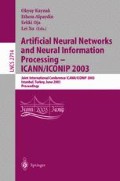Abstract
We discuss a Probably Approximate Correct (PAC) learning paradigm for Boolean formulas, which we call PAC meditation, where the class of formulas to be learnt is not known in advance. We split the building of the hypothesis in various levels of increasing description complexity according to additional inductive biases received at run time. In order to give semantic value to the learnt formulas, the key operational aspect represented is the understandability of formulas, which requires their simplification at any level of description. We deepen this aspect in light of two alternative simplification methods, which we compare through a case study.
Access this chapter
Tax calculation will be finalised at checkout
Purchases are for personal use only
Preview
Unable to display preview. Download preview PDF.
References
Valiant L.: A Theory of the Learnable. Communications of the ACM, Vol. 27 (1984) 1134–1142
Mitchell, T. M.: Machine Learning. McGraw-Hill Series in Computer Science. The McGraw-Hill Companies, Inc., New York (1997).
Selman, B., Kautz, H.: Knowledge compilation and theory approximation. In: Journal of the ACM, Vol. 43. (1996) 193–224
Michalski, R. S.: A theory and methodology of inductive learning. In: Machine Learning: An Artificial Intelligence Approach. J. G. Carbonell and T. M. Mitchell (eds.) Tioga, Palo Alto (1983) 83–134
Cover, T., Thomas, J.: Elements of information theory, Wiley, New York (1991).
Apolloni, B. and Malchiodi, D. and Orovas, C. and Palmas, G.: From synapses to rules. In: Cognitive Systems Research, Vol. 3/2(2002) 167–201
Qunilan, J. R.: C4.5: programs for machine learning. Morgan Kaufmann Publishers. San Mateo, California (1993)
Orovas, C. and Austin, J.: A Cellular Neural Associative Array for Symbolic Vision. In:Wermter, S. and Sun, R. (eds.): Hybrid Neural Systems. Springer-Verlag, Berlin Heidelberg New York (2000) 372–386
Vapnik V.: The Nature of Statistical Learning Theory. Springer-Verlag, Berlin Heidelberg New York(1995)
Ross Quinlan Home Page. http://www.cse.unsw.edu.au/~quinlan/
Author information
Authors and Affiliations
Editor information
Editors and Affiliations
Rights and permissions
Copyright information
© 2003 Springer-Verlag Berlin Heidelberg
About this paper
Cite this paper
Apolloni, B., Brega, A., Malchiodi, D., Palmas, G., Zanaboni, A. (2003). Learning Rule Representations from Boolean Data. In: Kaynak, O., Alpaydin, E., Oja, E., Xu, L. (eds) Artificial Neural Networks and Neural Information Processing — ICANN/ICONIP 2003. ICANN ICONIP 2003 2003. Lecture Notes in Computer Science, vol 2714. Springer, Berlin, Heidelberg. https://doi.org/10.1007/3-540-44989-2_104
Download citation
DOI: https://doi.org/10.1007/3-540-44989-2_104
Published:
Publisher Name: Springer, Berlin, Heidelberg
Print ISBN: 978-3-540-40408-8
Online ISBN: 978-3-540-44989-8
eBook Packages: Springer Book Archive

